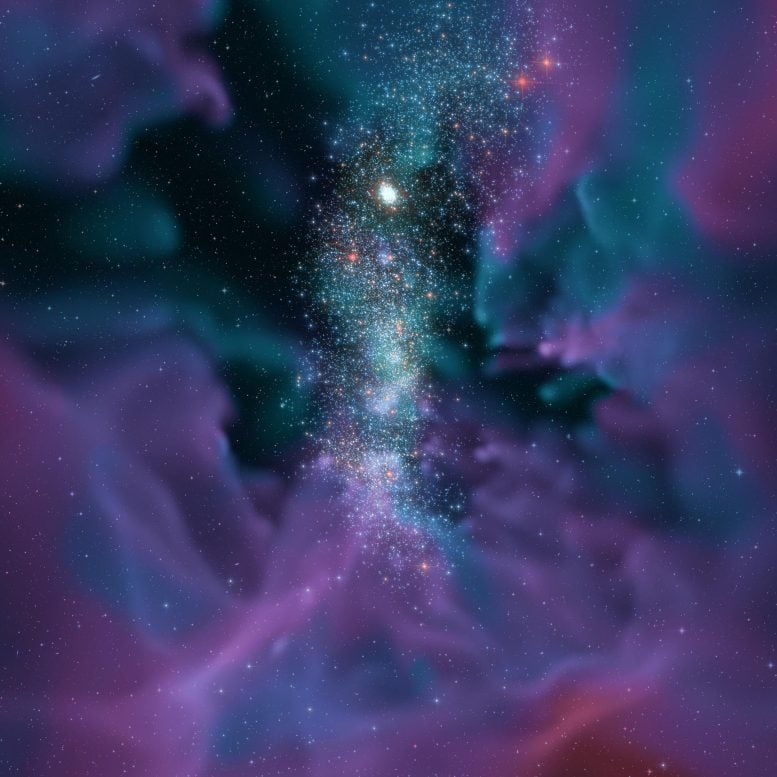
New simulations suggest globular clusters form in multiple ways and point to a mysterious new type of star system that may already lie hidden in the Milky Way.
For centuries, astronomers have tried to explain how globular clusters, among the oldest and densest stellar systems in the universe, first formed. Now, a study led by the University of Surrey and published in Nature says it has solved the mystery using detailed simulations – while also revealing a new class of object that may already exist in our own galaxy.
Globular clusters are tightly packed swarms containing hundreds of thousands to millions of stars that orbit larger galaxies, including the Milky Way. Unlike galaxies, they show no evidence of dark matter, and their stars are strikingly similar in age and chemical makeup – features that have kept scientists debating their origins since the 17th century.
To probe the problem, Surrey researchers ran ultra-high-resolution simulations that follow the Universe’s 13.8-billion-year history in unprecedented detail, letting them watch globular clusters arise in real time inside a virtual cosmos called EDGE. The results point to multiple formation routes and, unexpectedly, the appearance of a new type of star system – “globular cluster-like dwarfs” – that sits between globular clusters and dwarf galaxies in its properties.
A New Class of Object
Dr Ethan Taylor, Postdoctoral Research Associate at the University of Surrey’s School of Mathematics and Physics and lead author of the study, said: “The formation of globular clusters has been a mystery for hundreds of years, so being able to add additional context surrounding how they form is amazing. We were able to do this in our EDGE simulations without having to add anything special to make them appear, and it just brings the simulations that extra level of realism. Additionally, being able to find a new class of object in the simulations is very exciting, especially since we have already identified a handful of candidates that exist in our very own Milky Way.”
Working in collaboration with Durham University, the University of Bath, the University of Hertfordshire, Carnegie Observatories and the American Museum of Natural History in the USA, Lund University in Sweden and the University of Barcelona in Spain, researchers used the UK’s DiRAC National Supercomputer facility to run the EDGE simulations over several years. To put the scale into perspective, if the largest simulations were run on a standard or high-end laptop, they would take decades to complete. These simulations not only recreated realistic globular clusters and dwarf galaxies but also predicted a previously unknown class of object.
Conventional dwarf galaxies are typically dominated by dark matter, with around a thousand times more of the mysterious substance than stars and gas combined. However, the newly identified ‘globular cluster-like dwarfs’ appear similar to regular star clusters when observed, yet still contain a significant amount of dark matter – meaning telescopes may have already found them in the real universe and classified them as regular globular clusters. This small difference would place them in a unique position to study both dark matter and cluster formation.
Possible Candidates in the Milky Way
Several known Milky Way satellites, such as the “ultra-faint” dwarf galaxy Reticulum II, are likely candidates. If confirmed, they could become prime sites for the search for pristine, metal-free stars born in the early Universe and new locations to test models for the ever-elusive “dark matter”.
Professor Justin Read, Chair of Astrophysics at the University of Surrey, said: “The EDGE project set out to build the most realistic simulation of the very smallest galaxies in the Universe – one that could follow all 13.8 billion years of its history while still zooming in on the tiny details, like the blast from a single exploding star. It took years to run on the UK’s DiRAC National Supercomputer, but the payoff has been extraordinary. At a resolution of just 10 light-years, fine enough to capture the effects of individual supernovae, we’ve been able to show that globular clusters can form in at least two different ways, both without dark matter.”
The next step is to confirm the existence of these globular cluster-like dwarfs through targeted observations with telescopes, including the James Webb Space Telescope and upcoming deep spectroscopic surveys. If they do, it could give astronomers new ways to test dark matter theories and offer some of the best chances to find the Universe’s very first generation of “metal-free” stars.
Reference: “The emergence of globular clusters and globular-cluster-like dwarfs” by Ethan D. Taylor, Justin I. Read, Matthew D. A. Orkney, Stacy Y. Kim, Andrew Pontzen, Oscar Agertz, Martin P. Rey, Eric P. Andersson, Michelle L. M. Collins and Robert M. Yates, 10 September 2025, Nature.
DOI: 10.1038/s41586-025-09494-x
Never miss a breakthrough: Join the SciTechDaily newsletter.